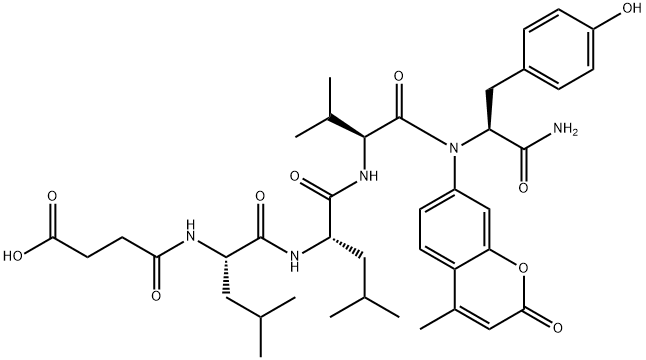Suc-Leu-Leu-Val-Tyr-AMC (94367-21-2) is a fluorogenic substrate for the chymotryptic activity of the 20S proteasome1 and other chymotrypsin-like proteases, as well as calpains2. A commonly used substrate for assaying proteasomal enzymatic activity.3,4 Excitation max.: 360 nm; emission max.: 460 nm.
Suc-Leu-Leu-Val-Tyr-AMC is a fluorgenic substrate for chymotrypsin-like proteases, as well as calpains. It can be used to treat tuberculosis.
ChEBI: A tetrapeptide compound with a succinyl group at the N-terminal and a 7-amino-4-methylcoumarin group at the C-terminal.
In the presence of chymotrypsin-like enzyme activity, the fluorophore, 7-amido-4-methylcoumarin is released from N-succinyl-Leu-Leu-Val-Tyr-7-amido-4-methylcoumarin. The fluorescence obtained is a measure of the enzyme activity.6
1) Stein et al. (1996), Kinetic characterization of the chymotryptic activity of the 20S proteasome; Biochemistry, 35 3899
2) Sasaki et al. (1984), Comparative specificity and kinetic studies on porcine calpain I and calpain II with naturally occurring peptides and synthetic fluorogenic substrates; J. Biol. Chem., 259 12489
3) Hamouda et al. (2014), The small heat shock protein B8 (HSPB8) confers resistance to bortezomib by promoting autophagic removal of misfolded proteins in multiple myeloma cells; Oncotarget, 5 6252
4) Min et al. (2017), USP14 inhibitor attenuates cerebral ischemia/reperfusion-induced neuronal injury in mice; J. Neurochem,, 140 826
